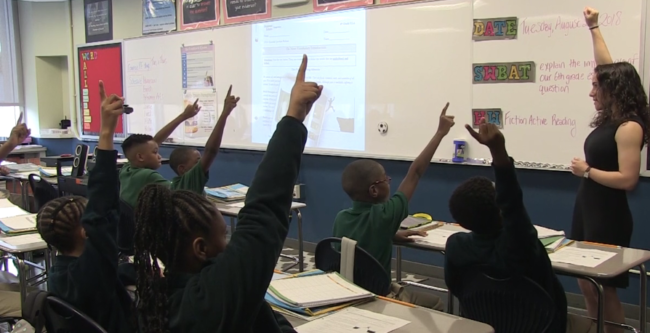09.07.18The First Days of School: Installing a Procedure While Teaching Content

Mallory Grossman builds strong habits of engagement & participation from Day 1
Jen Rugani is the newest member of Team TLAC. She’s a former Principal at Leadership Prep Canarsie Elementary in Brooklyn and a former TLAC teaching fellow. As a teacher and school leader she felt pretty strongly about what the start to a good school year looked like so a recent video really caght her eye. She writes:
Before the start of every school year, I was always gripped by the tension between two things that felt equally urgent in the first days: On one hand there was the long term imperative of establishing strong procedures and routines for the things my class would do over and over during the year, and on the other there was the urgency of digging into rich academic content- there was just no time to wait in getting started learning.
Sometimes these imperatives seemed to conflict – how could I find the time to reinforce both strong procedures and deep academics in the first days of school? By focusing on one, wouldn’t I be sacrificing the other?
That’s why I love this clip of Mallory Grossman on the first day of school at North Star Vailsburg Middle School.
BC.SystemsRoutines.GR6.Grossman.’Quick poll.’Clip2827 from TLAC Blog on Vimeo.
Mallory is teaching her students a procedure for something called Show Me (technique #5 in TLAC 2.0)–a routine students will use all year to present their responses to multiple-choice questions as a class and thus allow her to quickly gather data on their level of mastery.
This is a powerful routine to establish from the outset; it’s one that she’ll likely use every day and that will build value for her and her students all year–if she installs it carefully and correctly. But critically, Mallory finds a way to install the procedure–and practice it–while teaching real content.
In introducing the system, Mallory’s Economy of Language (part of the Strong Voice technique) is masterful. It takes her fewer than 30 seconds to explain the what (“We’re going to take a quick poll”) and how (“What that means is…”) of the routine, and she models the process so that students have a crystal-clear image of the expectation. Listen to the subtle-but-powerful beginnings of her What to Dos: “You’re going to put your fist just like this,” “You’re going to hold up a 1 if you chose A.” Mallory isn’t naming what she hopes to see; she’s naming what she knows she will see. She assumes the best of her students while also communicating that her expectations are non-negotiable, and her concision and clarity allow her students to jump right into successful practice.
And critically when they practice, it’s in the context of an authentic academic activity. Mallory resists the potential temptation to practice the routine in isolation (“Pick your favorite number 1-4 and show me”); instead, she has students complete an authentic vocabulary task and teaches the polling routine as a means of reviewing their responses. By grounding the routine within meaningful content, Mallory sends a strong message to her students from the very first day of school: “In this classroom, we are all about learning, and we make our systems precise because they help us learn.”
Another benefit of Mallory’s thoughtful planning her first day is that her students get multiple at-bats to master the routine. Every time students show their answer to a question, Mallory is not only checking their responses, she’s checking to make sure they’re nailing the process of the poll. Her overall pace of instruction is quick, but when students execute the routine, she slows down and exaggerates her scan, providing quick feedback (“Daniel, all the way up”) to ensure that her vision is met. These Be Seen Looking moments communicate to her students that she cares about what they think, and she cares that they show that thinking with confidence.
Even though she’s explicitly teaching a polling system, it’s worth noting Mallory’s warm, persistent reinforcement of other expectations throughout this clip. Whether she’s addressing lack of eye contact with a quick What to Do (“Make sure you’re tracking your peer”) or gently redirecting a student’s attention from his fallen pencil back to her directions (“It’s fine, thank you, Christian”), Mallory is constantly communicating and modeling respect for the learning and respect for the community. Moment by moment, student by student, she is intentionally and carefully building her classroom culture.
Mallory shows so beautifully in this clip that establishing a culture of strong systems and routines is establishing a culture of deep learning, and how we can make both happen from the very first day of school. If this is Day 1, I can’t wait to see what Mallory and her sixth-graders are accomplishing on Day 20, Day 90, and beyond.
